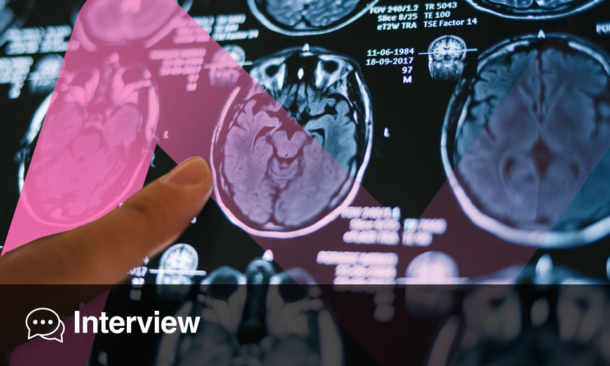Christina Dalla | Professor of Pharmacology, Medical School, National and Kapodistrian University of Athens, Greece; President, Hellenic Brain Council; President, Mediterranean Neuroscience Society; Communication Committee Chair, Federation of European Neuroscience Societies (FENS).
Citation: EMJ Neurol. 2025;13[1]:68-72. https://doi.org/10.33590/emjneurol/CGGR3952
![]()
EMJ spoke with Christina Dalla, a pioneering researcher in neuropsychopharmacology and expert in sex differences in neuropsychiatric disorders, to discuss her most impactful discoveries in depression and anxiety, and the potential of psychedelic treatments in mental health.
Your work largely focuses on sex differences in neuropsychiatric disorders, particularly in depression and anxiety. What are the most impactful or surprising findings that your work has uncovered?
We have been working on that for many years, since my PhD thesis, which was over 25 years ago. During my postdoctoral studies at Rutgers University, New Brunswick, New Jersey, USA, I also focused on sex differences, mostly in learning and neurogenesis. When I started my own lab, we continued exploring similar questions. One major area of focus has been identifying sex differences in baseline behaviours in male and female rats; although we sometimes also work with mice, we primarily use rats. A crucial early step was validating behavioural paradigms in females, which had often been overlooked. For example, in open field tests, female rats tend to be more active than males. We’ve also observed sex differences in learning behaviours, and in tests like the forced swim test. However, while these sex differences appear at baseline, they often disappear after administering antidepressants. In a way, these drugs equalise the behavioural responses between sexes. This suggests that, even if males and females start from different baselines or have different underlying neurochemical or neurobiological mechanisms, such as variations in serotonin levels, the drug could still have the same effect in some cases. This is very interesting.
For example, we have found that the corticosterone levels are different in females and males. We know that corticosterone tends to be higher in females, yet the deregulation of the hypothalamic–pituitary–adrenal (HPA) axis appears to play a more significant role in male depression. This is important for translational work, because many animal models of depression rely on stress and HPA axis dysregulation. I often see grant proposals that assume these mechanisms apply across sexes, but we have shown that this isn’t always the case. Understanding these differences is key before testing new drugs.
Another key point is the oestrous cycle, particularly when studying behaviours like those measured in the forced swim test. While the cycle does not change baseline behaviours in the forced swim test, it can vary the antidepressant response. That’s why it’s important to include both males and females, and to account for different phases of the oestrous cycle when possible. A drug could be effective only in males, or only in females during a particular phase of the cycle. It’s better to include different phases of the cycle or different developmental stages, like puberty or post-menopause. Of course, this approach is more time-consuming and more expensive, but it’s important, at least, to be aware of it and to take it into consideration.
A finding from our lab came from a former PhD student, now a psychiatrist, who identified the nucleus reuniens in the thalamus as a key player in the stress response. This brain region connects the prefrontal cortex and hippocampus. When we disrupted these regions in rats, they did not have a stress response, even under chronic mild stress; they were resilient to stressors. We later confirmed that this circuit plays a similarly crucial role in females. Our data, from behavioural studies, electrophysiology, and neuroplasticity indices, highlighted that the integrity of the prefrontal cortex–hippocampus circuit is essential for a normal stress response. That’s one of the most important findings from our lab, and it’s why we’re now focusing most of our research on this circuit.
Historically, there was a belief that females were more biologically variable due to hormonal changes, which led to their exclusion from many studies. However, more recent meta-analyses show that males can be just as variable, due to differences in testosterone levels. This assumption was likely driven by bias and convenience, and many studies treated females as smaller versions of males or ignored sex altogether. In older studies from the 1970s and 1980s, sometimes only females were used, and sometimes the sex of the animal wasn’t reported at all. In autoimmune disease research, females were used more often because autoimmune disorders, like multiple sclerosis, are more prevalent in females, and it’s easier to induce autoimmune disorders in them. Conversely, cardiovascular studies were mostly conducted in males, while learning studies sometimes used females because they performed better in certain tasks like classical conditioning. Our lab was among the first, 25 years ago, to start validating behavioural effects for animal models of psychiatric disorders in females, and conducting side-by-side comparisons of males and females.
Your recent research has highlighted the G protein-coupled oestrogen receptor 1 (GPER1) membrane oestrogen receptor as a rapid-acting target in psychopharmacology. Can you tell us more about this research, and explain the significance of GPER1 in the context of neuropsychiatric disorders?
Yes, this is an ongoing study. We’ve already had many results, and we are planning more experiments and grant applications to further explore its potential, as the findings so far have been very promising. GPER1 is a membrane-bound oestrogen receptor that differs from the classical oestrogen receptors, which are steroidal and located in the cytoplasm. Instead, GPER1 functions more like G-protein-coupled receptor (GPCR), enabling it to produce rapid, and non-genomic effects. We already have findings showing that activating GPER1 can have rapid antidepressant effects, mainly in females. We have also studied its potential as a chronic treatment, with results indicating that its long-term effects are comparable to selective serotonin reuptake inhibitors in depression models.
However, we believe it can also produce rapid effects. For example, we have done experiments involving local infusion into the hippocampus in both males and females, and we observed that the effect is mainly seen in females. Specifically, local infusion of a GPER1 agonist produced a rapid anxiolytic and antidepressant effect in females. We are planning further experiments using genetic tools to investigate what happens when we overexpress the receptor and then activate it with an agonist, and we are also considering knockdown studies to reduce the receptor’s expression. We believe this line of research is very promising, potentially for early intervention in depression, and particularly for women in menopause or perimenopause, when oestrogen levels start to decrease.
Of course, we know that oestrogens are not only produced in the ovaries and other glands, but are also locally synthesised in the brain, including in males. It is interesting to explore what happens when we manipulate these local effects as well. This could also have potential relevance for postpartum depression, since neuroestrogens are locally synthesised and act in the brain.
Beyond neuropsychiatric disorders, does this treatment have potential for other neurological disorders?
Yes, it does. In fact, it has been extensively studied in relation to cognition, and so it could be promising for dementia or Alzheimer’s disease. Alzheimer’s disease is more frequent in women than men, like depression and anxiety, so it could be particularly relevant for Alzheimer’s. It has also been studied for Parkinson’s disease, multiple sclerosis, and stroke, because neurosteroids, especially neuroestrogens, are also involved, and they can act like neuromodulators locally in the synapse. Thus, it could be promising for many different disorders that we may not even be aware of yet.
As a member of the European College of Neuropsychopharmacology (ECNP) Psychedelics Network, what are your upcoming research plans involving psychedelics, and what questions are you hoping to address?
This network is a very active and collaborative group. It brings together many of Europe’s leading experts, as well as connections to industry and patient groups, and I find it exciting to be part of such a dynamic community. For me, it was a natural progression to research psychedelics. I know it’s very much a current trend, and everybody wants to work on psychedelics, but my PhD thesis was on serotonin, depression, and sex differences. Of course, for me, it was the logical next step. So far, we have only done work with ketamine, which is not a classical psychedelic. It’s a dissociative drug, and we have mostly used ketamine as a positive control in our studies. By the end of this year, we plan to begin studies on classical psychedelics, primarily with psilocybin, and we hope to explore dimethyltryptamine and 55-methoxy-N,N-dimethyltryptamine in the future.
We participate at a Marie Curie doctoral network, a European initiative primarily supporting PhD students. Some of our collaborators are also members of the ECNP Psychedelics Network. The focus will mostly be preclinical, investigating sex differences in animal models of depression. One key question is whether the effects of psychedelics vary across the different phases of the oestrous cycle, which is relevant given that these are acute treatments. Understanding the optimal timing of administration may be essential for therapeutic outcomes.
We are also interested in analysing data from human studies to explore sex differences in response; for instance, differences between premenopausal or postmenopausal women, menstrual cycle phases, or the influence of hormonal contraceptives, which many women use. These factors remain largely unexamined, even though these drugs are already entering Phase III clinical trials and may soon be licensed, whereas in some countries they are already used for psychiatric indications. Understanding how to administer these treatments in women, and whether differential effects exist, is a key priority.
We also participate at a COST Action network, which supports broader European networking, advocacy, education, and dissemination efforts, and facilitates future grant applications. We are considering applying for Horizon Europe grants in the autumn or next year. At the university hospital, we’re fortunate to have a dedicated facility for human psychedelic studies, where psychiatrists are trained in investigational psychedelic use, and it’s exciting that we are starting this work. All clinical use will take place in controlled medical settings, similar to how ketamine is administered, which is currently only in hospital settings in Greece. I’m also a member of the committees at the national drug organisation in Greece that assess and authorise the use of these drugs. In our case, this will have to be within hospitals, under strictly controlled conditions. People are excited because they see a potential new treatment that acts effectively and quickly, unlike traditional antidepressants, which often take more than a month to show results and don’t work for everyone.
Is it possible for psychedelic treatment to be effective without any form of cognitive-behavioural therapy or psychotherapy, or are both always necessary for a positive outcome?
That’s a very good question, and one that remains open. There’s currently some debate among researchers on this topic. Many believe that the therapeutic effect of psychedelics depends on combining the drug with a very specific psychotherapeutic approach (not necessarily cognitive behavioural therapy), which they view as necessary. Others argue that psychotherapy may not always be necessary. At this stage, it’s still under investigation. What we do know is that the psychedelic experience itself appears to be crucial. This became clearer as studies moved away from the idea that microdosing might be sufficient. Most now support the notion that a full psychedelic experience is needed to achieve therapeutic outcomes. As for the psychotherapy component, having a therapist present not only enhances safety, but also likely improves the overall therapeutic benefit.
Do you anticipate any sex differences in the effects of psychedelics?
I would expect different responses, because psychedelics act on serotonin receptors, particularly serotonin 2A (5-HT2A) receptors, which have sex-based differences, and are also influenced by hormonal changes, such as fluctuations in oestrogen and progesterone. These hormonal variations could lead to different effects between sexes. It’s unclear whether these differences will be clinically meaningful, but it’s important to investigate. For example, some women experience physiological or emotional changes before menstruation, which could affect how they respond to psychedelics. It may be advisable to avoid administration during this phase. On the other hand, high oestrogen levels might interact with the drug, which could have implications for both safety and efficacy. Hormonal contraceptive use and menopausal status could also influence responses. We may need to consider dose adjustments or tailored approaches depending on these factors. Moreover, since neuroplasticity is known to fluctuate throughout the menstrual cycle, and psychedelics influence neuroplasticity, we might observe different effects depending on the cycle phase.
In your leadership roles with the Greek Association of Academic Women, the University of Athens Gender Equality Committee, and the ALBA Network, you are deeply involved in promoting diversity and equity in brain sciences. From your perspective, what progress has the field made towards greater inclusion, and what challenges remain?
I’m also involved in the gender equality initiatives, both at my university, where I serve on the Gender Equality Committee, and within the Mediterranean Neuroscience Society, where I am currently the President. I will soon transition to the role of Past President, having served for several years. Across these organisations, many of the same issues need to be addressed. In general, I think that there has been some progress, especially in Europe. There is progress and many efforts, including the ALBA Network, which is part of the Federation of European Neuroscience Societies (FENS). However, there is a lot of work to be done.
First of all, we need to change the mentality in some countries, as we still see many issues related to discrimination, not only against women, but also concerning sexual orientation, transgender individuals, and others. So, there is a lot to be done. In Greece, we have many women in research and neuroscience, and many students in medical schools as well. There are now a lot of women pursuing PhD studies, and even at the professor level, we have a significant number of women in academia. However, we still lack women in leadership positions. Sometimes, this is referred to as the glass ceiling effect, where women can only progress up to a certain point. At my school, we have never had a woman serve as Dean, or even Vice Dean. Thus, there is still much work to be done across different countries, and each country has its own specific issues. However, we’re trying, and there are many initiatives currently underway.







